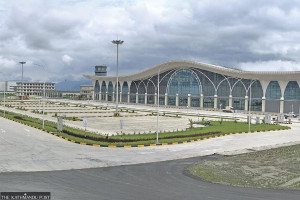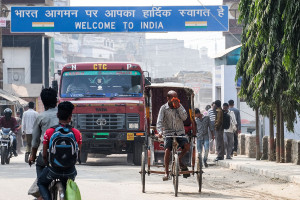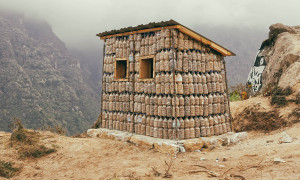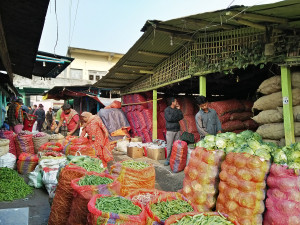Money
Buying summer clothes? You may sweat
Increased freight charges and customs duty mean higher price tags, retailers say.
Krishana Prasain
Like every evening after supper, when Prakriti Chaudhary was scrolling through Instagram, a beautiful one-piece summer dress on a shopping portal caught her attention. She asked the price, and was stunned to learn how much it cost.
“The price was Rs2,600 for just a one-piece dress and summer cardigan,” said Chaudhary, who works for an educational consultancy at Putali Sadak.
Apparels and shoes have become dearer, shoppers complain. The rise in prices is confirmed by central bank figures.
According to Nepal Rastra Bank’s macroeconomic and financial report, prices of clothes and footwear rose by 4.53 percent in the first seven months of the current fiscal year ended mid-February. The figure was 2.82 percent in the same period in the last fiscal year.
Consumer price inflation stood at 5.97 percent in the first seven months of the current fiscal year compared to 2.70 percent a year ago. Food and beverage inflation was recorded at 6.00 percent while non-food and service inflation reached 5.96 percent, the central bank stated. Transportation inflation increased by 15.87 percent in the first seven months of the current fiscal year, compared to 4.76 percent in the same period of the last fiscal year.
“Clothes have become dearer by almost 50 percent compared to pre-pandemic times as customs duty increased by 175 percent and shipping charges jumped by 300 percent,” Sumi Deepa Chhetri, proprietor of Dressmandu, a women's clothing and accessories store at Durbarmarg, told the Post.
"Clothes are being brought from China by chartered flights, which means shipping costs have increased by more than three times," said Chhetri, who imports most of her inventory from the northern neighbour. “Customs duty has also gone up, and all these increased charges are coming out of the customer's pocket.”
In a recent interview with the Post, Sunil Kumar Dhanuka, president of the Nepal Foreign Trade Association, said that freight costs have shot up sharply after the pandemic. It costs $6,000-$6,500 to ship a 20-foot container from China to Nepal, and $10,500-$11,500 to ship a 40-foot container.
Before the pandemic, the charges were $1,800-$2,000 for a 20-foot container and $2,800 for a 40-foot container.
A hike in freight costs squarely means an increase in the price of goods by more than 20-25 percent for traders which obviously is passed on to the consumer.
“The price of upcoming summer dresses is going to be higher as the government has made it compulsory to import goods by opening a letter of credit,” Chhetri said.
Would-be buyer Chaudhary is disappointed she could not add the dress she wanted so much to her wardrobe because it was so costly.
Chhetri says sales have not gone down despite the higher price tags.
“However, as the prices are expected to increase further in the coming days, I cannot say how the market will respond during the coming summer shopping season,” she added.
Economist Jagadish Chandra Pokharel says costlier clothing and footwear would bring down sales as incomes have not increased accordingly.
“People are currently more concerned about stretching their money,” he said. “A drop in clothing and footwear sales can be a factor in slowing down the economy as consumer spending is the main driver of Nepal's economy. The government can control hoarding to keep prices in check.”
According to the Trade and Export Promotion Centre, imports of apparels and clothing accessories swelled by 27.9 percent to Rs22.72 billion in the first seven months of the current fiscal year ended mid-February.
Nepal imported apparels and clothing accessories worth Rs30.10 billion in the last fiscal year 2020-21. In fiscal 2018-19, imports of apparels and clothing accessories were valued at Rs31.82 billion.
The country's footwear imports amounted to Rs5.60 billion in the first seven months of the current fiscal year, according to the Department of Customs.
Footwear imports totalled Rs6.77 billion in the fiscal year 2020-21 and Rs7.83 billion in 2018-19. Nepal imports most of its apparels, clothing accessories and footwear requirements from China.
According to a report by the United Nations Conference on Trade and Development published on November 18 last year, the global surge in container shipping rates could raise consumer prices by 2.2 percent in the least developed countries over the next year, based on an 8.7 percent increase in import prices.
Shipping costs are a key component of food and non-food prices in countries like Nepal.
Container freight rates skyrocketed amid a surge in demand for freight transport, shortage of shipping containers, and limited capacity and congestion at ports, the report said, adding that the impact was generally greater in smaller economies.
The report expected prices of textiles, clothing and leather products to increase by 10.2 percent.
While the global inflation rate was 2.8 percent last year, consumer price inflation in the least developed countries like Nepal was 22.4 percent, as per the report.
Apart from more expensive imports hitting consumers, domestic apparel manufacturers also said their cost of production had increased by more than 25 percent.
Suraj Raj Pandey, CEO and founder of Fibro, a Kathmandu-based apparel manufacturer, said the price of raw materials, which are mostly imported, had more than doubled. A surge in labour costs has also raised the cost of production, according to Pandey.
Chaudhary, meanwhile, has dropped her plan to add the apparel that she liked to her wardrobe.
“Considering the price of clothes, I think I will have to be satisfied with wearing the clothes I already have,” said Chaudhary. “I will rather be making only a few essential purchases.”




 9.12°C Kathmandu
9.12°C Kathmandu















